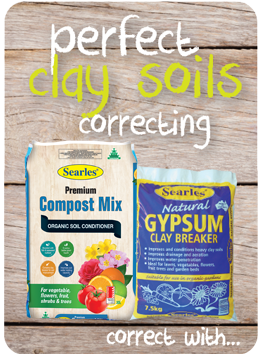|
When building new gardens it’s the perfect time to prepare the soil, and if you have clay soils, it is very important to build up the soil before planting.
Clay soils are usually very slow draining, and stick together in clods when wet. If they dry out, they crack and go as hard as bricks. If clay soils are left as they are, they can be a problem to grow plants in, but on a good note, clay soils are very rich in nutrients, they just require good preparation before planting.
To successfully grow plants in clay soils it’s important to both build up the soil with good organic matter and break up the clay with special additives.
PREPARATION
The first step is to add gypsum to the soil. Apply gypsum at 1 kilo per square metre, digging this into the top 10-15cm well. Gypsum works on the clay, breaking it up into small crumbly pieces making it easier to work with and also improves drainage. If the soil is a very heavy clay, then this may need to be done more than once.
The next step is to build up the soil with plenty of organic matter. Do this by digging in large quantities of Searles Premium Organic Compost. Spread the compost over the soil at about 5-6cm deep and turn this in with a fork to approximately 10cm deep. This may seem like a lot, but the results will be wonderful.
This added Searles Premium Organic Compost will improve soil fertility and help break up the soil, preventing it from drying hard like a brick. Now leave the soil undisturbed for a few weeks to settle and to allow the soil structure to change now with the addition of both the Gypsum and the compost.
If you are planting Australian Native plants, build up the soil with Searles Native Plants Specialty Mix. This mix contains all the right nutrient balance for their low phosphorus growing needs.
PLANTING
Before planting, give it a good turn with a fork and now you will see a world of difference. The soil should be far easier to turn and work and it should have a crumb-like soil texture. This is now ready to plant into. If you are growing seasonal crops such as vegetables or annual flowers, you will have the added advantage of being able to add more gypsum and compost again after each season.
Clay soils can be very rewarding and tend to grow excellent crops, given the right treatment. By constantly adding more organic matter year by year and mulching well, the soil will naturally improve and the benefits are enormous.
PLANTS FOR CLAY SOILS
Many Australian Natives can tolerate clay soils. Here is a list of Australian Natives and other plants suitable for clay soils.
• Callistemons (bottlebrushes) ‘Kings Park Special’, 'All Aglow' & 'Taree Pink'
• Melaleucas
• Some banksias such as B. spinulosa varieties and B. ericifolia
• Leptospermum 'Pink Cascade'
• Spotted emu bush - Eremophila maculata
• Melaleuca linariifolia ‘Claret Tops’
• Westringia fruticosa - Native Rosemary & Westringia longifolia
• Lomandra longifolia
• Leptospermum petersonii
• Brachyscome multifida 'Cut-Leafed Daisy'
• Scaveola 'Fan Flower'
• Dianella - Flax Lily
• Philotheca myoporoides (Long-leaf Wax Flower)
• Pandorea
So remember, to prepare clay soils:
- Add gypsum at 1 kg per square metre
- Dig in plenty of Searles Premium Organic Compost
- And leave for a few weeks or longer before planting
If you do this, you’ll be rewarded with a flourishing garden and soil that won’t dry like bricks.
|

---------------------------------
FOR MORE INFO
CLICK PRODUCT NAME BELOW
Premium Compost Mix
Natural Gypsum |






